- Clone
- 16A11 (See other available formats)
- Regulatory Status
- RUO
- Other Names
- KLRC1, NKG2B, NKG2AB6
- Isotype
- Mouse IgG2b, κ
- Ave. Rating
- Submit a Review
- Product Citations
- publications
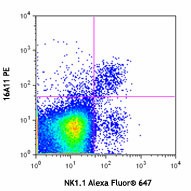
-

C57BL/6 mouse splenocytes were stained with NK1.1 Alexa Fluor® 647 and CD159a (NKG2AB6) (clone 16A11) PE (top) or mouse IgG2b, κ PE isotype control (bottom). -

| Cat # | Size | Price | Quantity Check Availability | Save | ||
|---|---|---|---|---|---|---|
| 142803 | 50 µg | $129 | ||||
| 142804 | 200 µg | $335 | ||||
CD159a, also known as NKG2A or KLRC1 (killer cell lectin-like receptor subfamily C, member 1), is a 43 kD type II transmembrane protein with extracellular C-type lectin domains. It belongs to the killer cell lectin-like receptor family also known as the NKG2 family. It is expressed on NK and NKT cells and activated CD8+ T cells. NKG2A binds to non-classical MHC class I molecule Qa-1 and causes inhibition of NK cell-mediated target-cell lysis.
Product DetailsProduct Details
- Verified Reactivity
- Mouse
- Antibody Type
- Monoclonal
- Host Species
- Mouse
- Immunogen
- C57BL/6 mouse CD94/NKG2A transfected CHO cells
- Formulation
- Phosphate-buffered solution, pH 7.2, containing 0.09% sodium azide.
- Preparation
- The antibody was purified by affinity chromatography and conjugated with PE under optimal conditions.
- Concentration
- 0.2 mg/ml
- Storage & Handling
- The antibody solution should be stored undiluted between 2°C and 8°C, and protected from prolonged exposure to light. Do not freeze.
- Application
-
FC - Quality tested
- Recommended Usage
-
Each lot of this antibody is quality control tested by immunofluorescent staining with flow cytometric analysis. For flow cytometric staining, the suggested use of this reagent is ≤0.5 µg per million cells in 100 µl volume. It is recommended that the reagent be titrated for optimal performance for each application.
- Excitation Laser
-
Blue Laser (488 nm)
Green Laser (532 nm)/Yellow-Green Laser (561 nm)
- Application Notes
-
This product may be used for research purposes only. It is not licensed for resale and may only be used by the buyer. This product may not be used and is not licensed for clinical assays, where the results of such assays are provided as a diagnostic service. If a diagnostic or therapeutic use is anticipated, then a license must be requested from the University of California. The availability of such diagnostic and therapeutic use licenses cannot be guaranteed from the University of California.
-
Application References
(PubMed link indicates BioLegend citation) -
- McMahon CW, et al. 2002. J. Immunol. 169:1444. (FC)
- Vance RE, et al. 2002. P. Natl. Acad. Sci. USA 99:868. (FC)
- Product Citations
-
- RRID
-
AB_10959654 (BioLegend Cat. No. 142803)
AB_10965542 (BioLegend Cat. No. 142804)
Antigen Details
- Structure
- Type II transmembrane protein with extracelluar C-type lectin domains, complexed with CD94; 43 kD
- Distribution
-
NK cells and NK T cells from C57BL/6 mouse
- Function
- Inhibitory activity via ITIMs
- Ligand/Receptor
- Non-classical MHC-I molecule Qa-1
- Cell Type
- Embryonic Stem Cells, Mesenchymal Stem Cells, NK cells, NKT cells
- Biology Area
- Cell Biology, Immunology, Signal Transduction, Stem Cells
- Molecular Family
- CD Molecules, MHC Antigens
- Antigen References
-
1. Vance RE, et al. 1998. J Exp Med. 188:1841-8.
2. Lohwasser S, et al. 1999. Eur J Immunol. 29:755-61.
3. Sivakumar PV, et al. 1999. J Immunol. 162:6976-80.
4. Silver ET, et al. 1999. Immunogenetics 49:727-30.
5. Vance RE, et al. 1999. J Exp Med. 190:1801-12. - Gene ID
- 16641 View all products for this Gene ID
- UniProt
- View information about CD159a on UniProt.org
Related Pages & Pathways
Pages
Related FAQs
- What type of PE do you use in your conjugates?
- We use R-PE in our conjugates.
Other Formats
View All CD159a Reagents Request Custom Conjugation| Description | Clone | Applications |
|---|---|---|
| PE anti-mouse CD159a (NKG2AB6) | 16A11 | FC |
| Purified anti-mouse CD159a (NKG2AB6) | 16A11 | FC |
| APC anti-mouse CD159a (NKG2AB6) | 16A11 | FC |
| PE/Cyanine7 anti-mouse CD159a (NKG2AB6) | 16A11 | FC |
| TotalSeq™-A0927 anti-mouse CD159a (NKG2AB6) | 16A11 | PG |
| TotalSeq™-C0927 anti-mouse CD159a (NKG2AB6) | 16A11 | PG |
| TotalSeq™-B0927 anti-mouse CD159a (NKG2AB6) | 16A11 | PG |
Customers Also Purchased
Compare Data Across All Formats
This data display is provided for general comparisons between formats.
Your actual data may vary due to variations in samples, target cells, instruments and their settings, staining conditions, and other factors.
If you need assistance with selecting the best format contact our expert technical support team.
-
PE anti-mouse CD159a (NKG2AB6)
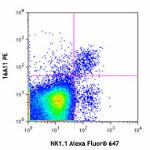
C57BL/6 mouse splenocytes were stained with NK1.1 Alexa Fluo... 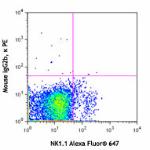
-
Purified anti-mouse CD159a (NKG2AB6)
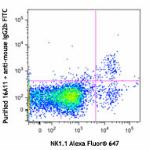
C57BL/6 mouse splenocytes were stained with NK1.1 Alexa Fluo... 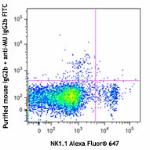
-
APC anti-mouse CD159a (NKG2AB6)

C57BL/6 mouse splenocytes were stained with NK1.1 (clone PK1... 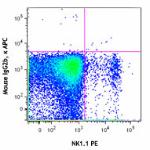
-
PE/Cyanine7 anti-mouse CD159a (NKG2AB6)

C57BL/6 mouse splenocytes were stained with TruStain fcX™ (c... -
TotalSeq™-A0927 anti-mouse CD159a (NKG2AB6)
-
TotalSeq™-C0927 anti-mouse CD159a (NKG2AB6)
-
TotalSeq™-B0927 anti-mouse CD159a (NKG2AB6)
 Login/Register
Login/Register 










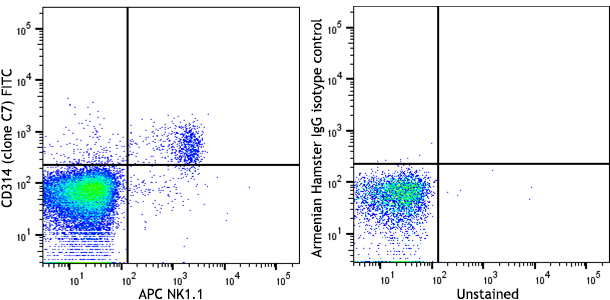
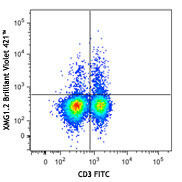

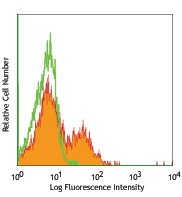



Follow Us